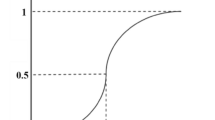Abstract
Portfolio optimization is one of the most important issues in the financial world, so investors are trying to make decisions that are most in line with the real world. But the uncertainty in data and parameters, and the contradiction in the investor’s goals, adds to the complexity of the stock portfolio optimization problem, and the other hand because of the efficient market, it is necessary to use multi-period models that, unlike single-period models, allow the investor to review their wealth at the beginning of each period. In this paper We formulate a bi-objective mean- CVaR portfolio optimization model based on General Fuzzy theory. Then the proposed model is solved by the Epsilon constraint method. Finally, we use the data of 15 companies from different industries operating in the Iran Stock Exchange Market in 1398, we examine the validity of the model and its efficiency.
Access this chapter
Tax calculation will be finalised at checkout
Purchases are for personal use only
Similar content being viewed by others
Notes
- 1.
Value at Risk.
References
Zadeh, L.: Fuzzy Sets. Information and Control, pp. 338–353 (1965)
Zadeh, L.: Fuzzy sets as basis for theory of possibility. Fuzzy sets and Syst. 1, 3–28 (1978)
Markowitz, H.: Portfolio Selection. J. Finance 7, 77–91 (1952)
Black, F., Litterman, R.: Global portfolio optimization. Financial Anal. J. 48(5), 28 (1992)
Mohammadi, S.E., Mohammadi, E.: Robust portfolio optimization based on minimax regret approach in Tehran stock exchange market. J. Ind. Syst. Eng. 11, 51–62 (2018)
Peykani, P., Mohammadi, E., Emrouznejad, A., Pishvaee, M.S.: Fuzzy data envelopment analysis: an adjustable approach. Expert Syst. Appl. 136, 439–452 (2019)
Tobin, J.: Liquidity preference as behavior toward risk. Risk Averation and Portfolio choice (1965)
Li, D., NG, W.: Mathematical finance. optimal dynamic portfolio selection: multiperiod mean-variance formulation. 10, 387–406 (2000)
Wei, S., Ye, Z.: Multi-period optimization portfolio with bankruptcy control in stochastic market. Math. Comput. 186, 414–425 (2007)
Calafiore, G.C.: Multi-period portfolio optimization with linear control policies. Automatica 44, 2463–2473 (2008)
Najafi, A.A., Mushakhian, S.: Multi-stage stochastic mean–semivariance–CVaR. Appl. Math. Comput. 256, 445–458 (2015)
Sun, Y., Aw, G., Teo, K.L., Zhu, Y., Wang, X.: Multi-period portfolio optimization under probabilistic risk measure. Finance Res. Lett. 18, 60–66 (2016)
Hassanlou, K.:A multi period portfolio selection using chance constrained programming. Decis. Sci. Lett. pp. 221–232, (2017)
Mohebbi, N., Najafi, A.A.: Credibilistic multi-period optimization based on scenario tree. Phys. A 492, 1302–1316 (2018)
Zhang, J., Li, Q.: Entropy, credibilistic mean-semi-entropy model for multi-period portfolio selection with background risk. vol. 21 (2019)
Liu, Y., Zhang, W., Gupta, P.: Multi-period portfolio performance evaluation model based on possibility theory. Transactions on Fuzzy Systems (2019)
Gupta, P., Mehlawat, M.K., Yadav, S., Kumar, A.: Intuitionistic fuzzy optimistic and pessimistic multi-period portfolio Intuitionistic fuzzy optimistic and pessimistic multi-period portfolio. Soft Computing (2020)
Mousazadeha, M., Torabia, S.A., Pishvaeeb, M. S.: Health service network design: a robust possibilistic approach. In: International Transactions in Operational Research, pp. 337–373 (2018)
Miettinen, K., Molina, J., González, M., Hernández-Díaz, A., Caballero, R.: Using box indices in supporting comparison in multiobjective optimization. Euro. J. Oper. Res. 197, 17–24 (2009)
Cohon, J.: Multicriteria programming: brief review and application. Design optimization, pp. 163–191 (1985)
Chankong, V., Haimes, Y.Y.: Multiobjective decision making: theory and methodology (1983)
Author information
Authors and Affiliations
Corresponding author
Editor information
Editors and Affiliations
Rights and permissions
Copyright information
© 2021 The Author(s), under exclusive license to Springer Nature Switzerland AG
About this paper
Cite this paper
Khandan, Z., Mohammadi, E. (2021). A New Fuzzy Approach for Multi-period Portfolio Optimization Under Uncertainty. In: Allahviranloo, T., Salahshour, S., Arica, N. (eds) Progress in Intelligent Decision Science. IDS 2020. Advances in Intelligent Systems and Computing, vol 1301. Springer, Cham. https://doi.org/10.1007/978-3-030-66501-2_25
Download citation
DOI: https://doi.org/10.1007/978-3-030-66501-2_25
Published:
Publisher Name: Springer, Cham
Print ISBN: 978-3-030-66500-5
Online ISBN: 978-3-030-66501-2
eBook Packages: Intelligent Technologies and RoboticsIntelligent Technologies and Robotics (R0)




